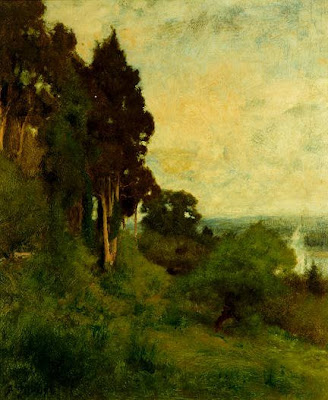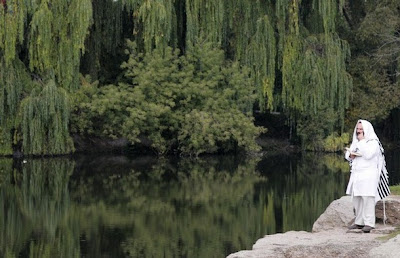
(Painting by George Inness)
Space Cadet dedicates this poem to his old artist-friend Sylvia ("Sura") Zeldis, who first told him about Josef Albers' book, "Interaction of Color."1.
Catskills shrouded by clouds and mist
Sheltered from inquisitive
Sunlight. In the valley below
Gamblers brave icy roads to Monticello
Minivans en route to bungalows.
In the summer, tourist shops proliferate
Like maggots under a rotted log.
Let me wander these derelict trails
And purify my ears with the song of a mountain stream!
2.
Where once resort hotels straddled the hills
Grossinger’s, The Concord, Tamarack Lodge
Gurus stroll in saffron robes, consoling
Escaped convicts of affluence.
On decrepit porches, Chassidim remember
The country life. Yiddish signs by the roadside
Like old world scholars attempt to refute
These indifferent woods.
Beside the emerald moss, ants build fallout shelters
Flies and chiggers conspire with the wind.
What’s the difference to a bent old man
Preoccupied with making a fire from sticks
Who sips hot tea in the dwindling light
A fading shadow in the unknown
Encroaching night?
3.
I wanted a way out of the city --
Really a way out of my mind.
Be still! I commanded
Enough commotion!
On a wooded slope, beside a flowing stream,
In company of owl, raccoon, and prowling bear,
I made my wilderness camp.
But the noise came along with me:
An endless parade of thoughts, happy and sad
Like unwanted relatives at a country outing.
Help yourself, my friends, I told them.
In these trees, there’s plenty of room.
But I can’t pay attention to you right now.
It is time to gaze at the endless sky
To sit beside the tide waters of my breath.
4.
Once I lived in the city.
Studied, then went to work
Married and raised a family.
Like a fish caught in the net
Floundering in obligations
Struggling with debt
I sought to escape loss and pain
Fought back a smile at praise
And tried to evade blame --
To no avail!
Now the four walls of my house are
The four winds. When I’m hungry
I cook some carrots or potatoes
Stored away from summer
Or swallow a handful of berries
Gathered in hidden recesses of the forest.
Sometimes hikers pass this way
Fresh-faced, wearing their Bean Catalog parkas
When they see me, they laugh at the ragged stranger
And I laugh, too. But my laugh is not their laugh.
In the unformed shadow of sight and sound
The mind finds repose.
From colorless light
All colors come forth and return.
5.
Pausing beside a mountain stream
I lean over to drink – and on the water
See an unfamiliar face, white haired
White bearded, weather-worn
Like a rusty “No Trespassing” sign.
What did I look like before?
Did that face, too, belong to me?
In the ripples of the brook
The face changes shape.
Blurred trees and a patch of sky turn into
A painting by old hermit Monet
With his brushes strapped to his wrists.
What is this world of appearances
But a reflection on the fathomless water
Of the divine thought?
6.
Lipa has become my benefactor.
He works at the Satmar camp all summer
Lets me mooch leftovers from the kitchen.
Now he has brought a portable heater
To my ramshackle bungalow
Plastic for the broken windows
An old army cot to keep my bones
Off the cold floor.
“Get out of here!” I cry.
“God created the world out of kindness,”
Says the burly intruder
Shoving a box across the floor
Crammed with canned peaches, beans and rice.
He probably never had an introspective
Moment in his life.
But heaven’s wondrous purpose
Lipa knows.
7.
Lying on a lounge chair of leaves
I study the white clouds sailing
Across the vault of heaven, like thoughts
Coming out of nowhere
Clouds turn into sky
Sky turns into clouds
Thought dissolves into no-thought
No-thought congeals into thought
Yesh (something) turns into ayin (nothing)
Ayin gives rise to yesh
In essence, it’s all the same.
“When I die,” the Baal Shem Tov
Told his daughter, “It will be like going
From one room to the next.
Not even that!
It will be like going from one corner to the other.”
8.
Josef Albers painted bands
Of color in various combinations.
The same orange surrounded
By turqouise looks so different
Surrounded by crimson.
So what are we
But our contexts?
And if you say, step out of them all
I say, there’s nowhere to go.
Solitude
Is also a context. Its colors, too
Never stop changing.
9.
City folks say that the hermit’s life
Is a cop-out. If everyone
Cut their umbilical cord to Gas & Electric
IRS, New York Times, CNN
What would become of the world?
Poor world!
I say that taking your mind off what you’re doing
Is a bigger cop-out.
10.
In the Catskills, I devised a plan
For world peace. One that works!
Rabbi Nachman says that all disputes,
All warring nations, are in our minds.
In the moonlight, I listen to crickets
Scratching their legs. The same rhythm
The same pitch. There is no dissonance.
“The desire to achieve transcendence
Is also a desire!” the critic contends.
“Yes,” the sage replies.
“But to fulfill that desire, you must overcome
Every other!”
If the hermit’s life is so easy
Let’s see how long you can last here!








































